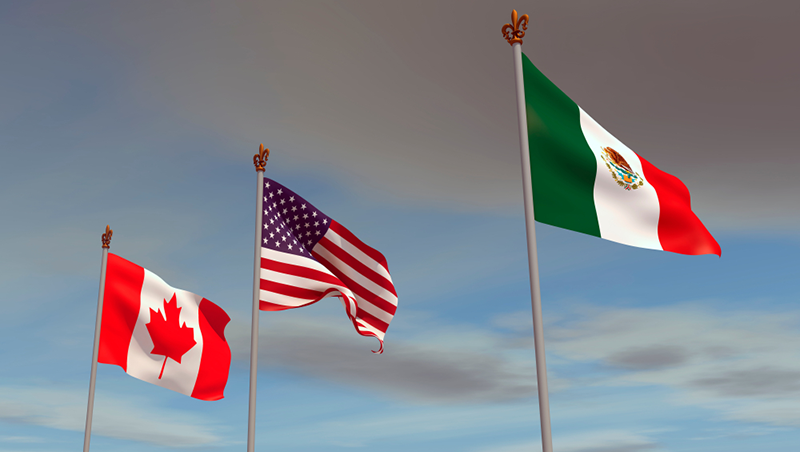US-Mexico Tax Treaty
Navigating tax matters across the US-Mexico border requires a solid grasp of the US-Mexico Tax Treaty, an agreement that defines the rules governing...

The USMCA (United States-Mexico-Canada Agreement) is version 2.0 of the NAFTA (North American Free Trade Agreement). Since its implementation in 2020, it has been a key tool for strengthening trade ties between participating countries. Basically, its function is to remove obstacles and facilitate the commercial exchange of goods and services.
The main purpose of the USMCA is to facilitate and reduce the cost of trade between Mexico, the United States, and Canada. The treaty functions as a kind of trade manual that benefits the economies of member countries.
In the case of the Mexican economy, for example, the treaty boosts exports, especially in key sectors such as manufacturing. Furthermore, it facilitates the influx of foreign investment, which strengthens economic growth, creating more jobs and opportunities.
Another key advantage for all participants is greater financial stability with a more balanced exchange rate. Furthermore, preferential access to global markets promotes foreign trade and, consequently, the development of labor markets.
The USMCA represents a great opportunity for companies seeking to grow. It simplifies the export of products by eliminating or reducing tariff barriers. This provides access to desired markets and, in turn, facilitates foreign investment, which increases the capital available for growth.
Millions of jobs are linked to the trade relations promoted by this agreement. Part of its achievements has been to improve working conditions and protect workers' rights, creating a more stable and competitive environment.
In short, the USMCA is the foundation of trade in North America. However, its constitution is relatively recent and represents an evolution of a previous treaty. In this sense, the USMCA incorporates entire chapters on digital trade, phytosanitary measures, transparency mechanisms, and competition rules. In doing so, it establishes a more comprehensive framework that allows the three countries to adapt to new economic and technological realities.
These provisions seek to ensure that international transactions take place in a more reliable and regulated environment. This is crucial in an environment of increasingly interdependent supply chains.
The USMCA replaced the North American Free Trade Agreement (NAFTA). The former was a trade agreement intended to benefit the three signatory countries: Mexico, the United States, and Canada.
NAFTA was designed with the following objectives (which were later supported by the USMCA):
that the signatory countries enjoy the best possible trading conditions among themselves;
eliminate trade barriers and facilitate the cross-border movement of goods and services;
promote conditions of fair competition;
increase investment opportunities; provide protection and enforcement of intellectual property rights;
establish procedures for the resolution of trade disputes;
Implement a framework for greater trilateral, regional, and multilateral cooperation to enhance the benefits of the trade agreement.
This first treaty was signed in 1988 and endorsed in 1991. The signatories were Brian Mulroney, Canadian Prime Minister, George Bush, President of the United States, and Carlos Salinas de Gortari, President of Mexico. NAFTA entered into force on January 1, 1994.
From then until 2015, trade between the three countries quadrupled: from $297 billion to $1.14 trillion. This boosted the economies involved and reduced prices for consumers.
Thus, since NAFTA entered into force, the exports and imports of the member countries have boosted their trade balance.
This can be illustrated very well with the case of Mexico. One year before NAFTA came into force, exports represented 12.14% of the country's gross domestic product (GDP). Five years later, they reached more than 35%. Imports registered the same trend, reaching 37% of GDP, a trend that continued for more than two decades.
Likewise, in terms of Foreign Direct Investment, the three states benefited from proposals that mobilized millions of dollars during the treaty's term.
It is essential to note that NAFTA was, at the time, one of the most ambitious international agreements signed. It represented an innovation because it combined economies at different levels of development, introducing clauses that forced a rethinking of production chains. This aspect made it a model for other subsequent free trade agreements, which adopted similar schemes.
NAFTA eliminated many of the trade barriers that existed between participating states and increased investment opportunities. It also established procedures for resolving trade disputes and even increased the competitiveness of the three countries in the global marketplace.
However, it also had negative impacts that precipitated its demise. It affected employment and activity in certain sectors, such as agriculture in Mexico. Toward the end, President Donald Trump initiated renegotiation of the agreement during his first term, which would lead to the current USMCA.
The First Round of Negotiations to modernize and update NAFTA took place in Washington, D.C., from August 16 to 20, 2017. President Trump's statements and actions against Mexico and Canada permanently complicated the negotiation process.
The Second Round of Negotiations took place from September 1 to 5, 2017. Progress was made on the following topics: competition, SMEs, digital trade, trade barriers, and terms of trade. Three more rounds followed that year, in Ottawa and Mexico. The following year, 2018, saw a total of eight negotiated rounds.
On July 1, 2018, Andrés Manuel López Obrador was elected the president of Mexico. He declared his commitment to concluding the new NAFTA negotiations as soon as possible, adding Jesús Seade to Mexico's negotiating team.
This aspiration would be realized on November 30, 2018, at the Group of 20 (G20) summit held in Argentina. Presidents Enrique Peña Nieto, Donald Trump, and Justin Trudeau signed the USMCA. However, it wasn't until July 1, 2020, that it actually entered into force.
The transition process between the two treaties was not only political but also social and economic. There were intense debates about how the new agreement should incorporate issues. Among them, sustainability, digital rights, and gender equity in trade stood out as critical. This resulted in more detailed chapters and clearer commitments for each nation.
Although the USMCA and NAFTA are trade agreements between the same countries, they have significant differences that mark their evolution. A good example is the automotive industry. The rules of origin increased the proportion of parts that must be manufactured in North America to avoid tariffs.
Furthermore, the USMCA is better adapted to the digital world, with rules governing e-commerce, data protection, and labor rights. It also imposes higher standards for working conditions and environmental protection, something that NAFTA did not address with the same precision.
Another substantial difference lies in the dispute resolution mechanisms. The USMCA introduces a more robust framework to ensure that disputes can be resolved efficiently, avoiding protracted conflicts that affect trade.
The agreement also incorporates periodic review clauses, establishing that its validity and relevance must be assessed every certain number of years. This allows for constant updates, making it more flexible to changes in the global economy.
In conclusion, the USMCA not only constitutes a technical update to NAFTA but also a redesign of the rules of trade in North America. Its emphasis on innovation, labor protection, and adaptation to the digital economy makes it a more robust treaty.
The future will show to what extent these changes balance national and regional interests, promoting more inclusive and sustainable growth for all three countries.
The USMCA not only represents a framework for free trade but also acts as a catalyst for change in specific sectors of the North American economy. In the energy sector, for example, the agreement establishes guidelines that foster cooperation between the three countries to ensure a more stable and competitive supply.
Although each nation retains sovereignty over its natural resources, the importance of energy integration is recognized. This is key, given the region's steadily growing demand for electricity, gas, and fossil fuels. This integration can foster binational and trilateral projects that strengthen regional energy security.
In the field of technology and the digital economy, the USMCA is ahead of previous agreements. By including specific chapters on e-commerce, data protection, and cross-border information flows, it establishes clear rules for an activity that is essential today.
This not only provides security for businesses but also gives greater confidence to consumers, who benefit from a more transparent digital marketplace. The harmonization of digital standards allows companies of different sizes to participate on a level playing field, creating opportunities for innovation and competitiveness.
Regarding the agricultural sector, the USMCA seeks to balance benefits through stricter phytosanitary and market access provisions. This contributes to greater price stability and ensures that agricultural products circulate with consistent sanitary standards. In the long term, this aspect can strengthen regional food security, although it also poses challenges for small producers who must comply with more stringent regulations.
The services sector, which represents an increasingly high percentage of GDP in all three countries, also finds a favorable framework in the agreement. The mutual recognition of professional certifications and the reduction of barriers to labor mobility boost integration. The same is true of the inclusion of provisions related to intellectual property in creative services. This sector is expected to grow as more companies access neighboring markets without facing unnecessary barriers.
Compared to other global free trade agreements, the USMCA offers a greater level of detail and regulatory updates. For example, compared to the European Union agreements, the USMCA maintains a more pragmatic approach. And, in relation to Mercosur, the North American treaty is more ambitious in opening markets and adapting to the digital economy.
Looking ahead, the challenges of the USMCA are multiple. One of them is automation, which is transforming the manufacturing industry and could directly impact employment levels.
Another challenge is sustainability: while the agreement includes environmental clauses, actual compliance will depend on governments' ability to implement and monitor them. Climate change and the transition to clean energy will require coordinated efforts that go beyond what was established in the original text. The same applies to the design of more responsible production chains.
The evolution of the digital economy also raises questions. With artificial intelligence, data trading, and transnational platforms booming, it will be essential for the USMCA to stay up-to-date. The agreement's periodic review clause takes on strategic relevance here. This will allow the rules to be adjusted to the speed with which these technologies advance.
In political terms, the agreement will continue to be the subject of internal debate in each country. Some will defend it for its benefits in terms of employment, investment, and market access. On the other hand, it will also be criticized for limiting economic autonomy or harming certain productive groups. This tension is inherent in any large-scale agreement and will be part of the adaptation process in the coming years.
At the end of the day, the USMCA not only consolidates trade cooperation in North America. It also projects a future where economic integration is more closely linked to innovation, sustainability, and resilience. If countries can coordinate and take advantage of the opportunities the treaty offers, they will be able to maintain their relevance in an increasingly competitive global landscape. In this sense, the USMCA is emerging as a strategic platform for addressing the economic transformations of the 21st century.

Navigating tax matters across the US-Mexico border requires a solid grasp of the US-Mexico Tax Treaty, an agreement that defines the rules governing...

The United States-Germany Income Tax Treaty between the Federal Republic of Germany and the United States of America is pivotal in facilitating...

The U.S.-Belgium tax treaty is designed to prevent double taxation and promote tax fairness between the two countries. It outlines how various types...